History
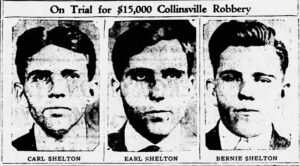 During the Prohibition-era there were many people who opposed the new laws prohibiting the sale and manufacturing of alcohol, in any form. As with any such restriction, there were plenty of people who were willing to take matters into their own hands and make, in this case, illegal liquor. It was a profitable business, and there were a number of people and gangs who wanted in. The Shelton Brothers Gang had a good thing going, when the famous bootlegger, Charles Birger and his gang wanted in.
During the Prohibition-era there were many people who opposed the new laws prohibiting the sale and manufacturing of alcohol, in any form. As with any such restriction, there were plenty of people who were willing to take matters into their own hands and make, in this case, illegal liquor. It was a profitable business, and there were a number of people and gangs who wanted in. The Shelton Brothers Gang had a good thing going, when the famous bootlegger, Charles Birger and his gang wanted in.
The Shelton Brothers Gang had other ideas, however. Both gangs were based out of southern Illinois. The best way to control the market price, is to be the only game in town. With all the fighting for supremacy, the Shelton Brothers Gang would allegedly be known as “America’s Bloodiest Gang” when the fighting quickly became a “Turf War.” The Shelton Brothers Gang was formed by Carl (born 1888), Earl (born 1890), and Bernie “Red” Shelton (born 1898) of “Geff” Jeffersonville, Wayne County, Illinois. They started their gang shortly after Prohibition came into effect in 1920, operating mostly in Williamson County, Illinois, making moonshine and other illegal alcoholic beverages. The operation grew, and they eventually dominated both gambling and liquor distribution in Little Egypt until 1926. That’s when a former ally now turned nemesis, gangster Charles Birger, attempted to take over 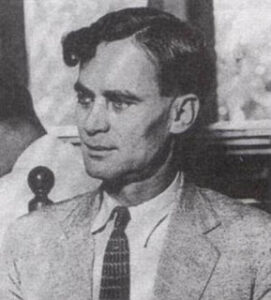 the Sheltons’ bootlegging operations. The result was a violent gang war. The weapons were varied. Both sides use homemade armored trucks and included an eventually included an aerial bombing raid by the Sheltons on Birger’s Shady Rest headquarters. They were out of control, and with the “stepped-up attacks” came what was considered the first bombing from a plane on US soil. Strangely, the “Turf War” was also responsible for keeping the KKK out of their general area after the constant flare ups into fights. The battle was for the control of bootlegging in all of southern Illinois and nothing more.
the Sheltons’ bootlegging operations. The result was a violent gang war. The weapons were varied. Both sides use homemade armored trucks and included an eventually included an aerial bombing raid by the Sheltons on Birger’s Shady Rest headquarters. They were out of control, and with the “stepped-up attacks” came what was considered the first bombing from a plane on US soil. Strangely, the “Turf War” was also responsible for keeping the KKK out of their general area after the constant flare ups into fights. The battle was for the control of bootlegging in all of southern Illinois and nothing more.
The whole thing was brutal in every way, and finally, the Shelton Brothers were set up and blamed for a murder they did not commit. Based on the testimony of Birger and Art Newman, the Shelton Brothers were convicted of an unsolved 1925 mail carrier robbery of $15,000 and sentenced to 25 years in prison, but they were later released. In the meantime, without its leaders, the Shelton Brothers Gang slowly faded, and just as he had planned, Birger dominated bootlegging in Southern Illinois, until he was hanged in 1928 after being convicted of ordering the murder of West City, Illinois, Mayor Joe Adams, who was a Shelton supporter. Eventually, the Shelton Brothers Gang was released for lack of evidence against them. The decided to move the operation to Peoria, Illinois, and focus mainly on gambling. They built an alliance with known gangsters like Al Capone and 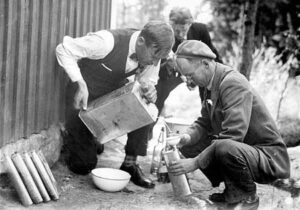 dominated their territory with very few serious rivalries. They did, however, come to the attention of the Federal Officials who eventually placed a $15,000 bounty on each of the Sheltons heads. Carl and Bernie Shelton were both murdered in 1948, on orders from former gang member Frank “Buster” Wortman, who had taken over the Shelton operations while they were in prison. Worman dominated Saint Louis’ illegal gambling and other criminal activities until his death in 1968. Earl Shelton was also ambushed and shot, but he survived. The hits just kept coming, and after a third attempt on his life in the early 1950s, Earl and his family left Illinois for Florida. Earl lived a quiet life there, and in 1986 at age 96, he passed away. He was the last member of the Shelton Brothers Gang.
dominated their territory with very few serious rivalries. They did, however, come to the attention of the Federal Officials who eventually placed a $15,000 bounty on each of the Sheltons heads. Carl and Bernie Shelton were both murdered in 1948, on orders from former gang member Frank “Buster” Wortman, who had taken over the Shelton operations while they were in prison. Worman dominated Saint Louis’ illegal gambling and other criminal activities until his death in 1968. Earl Shelton was also ambushed and shot, but he survived. The hits just kept coming, and after a third attempt on his life in the early 1950s, Earl and his family left Illinois for Florida. Earl lived a quiet life there, and in 1986 at age 96, he passed away. He was the last member of the Shelton Brothers Gang.
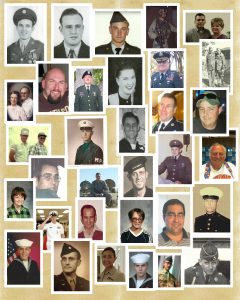 Where would a nation be without its soldiers? In deep trouble. Our world, at this time in history is at its most volatile. To top it off, being in the service has been voluntary for a long time now. That means two things. First that fewer people might be entering the service; and second, that the ones who join, want to be there and will work harder. Being in the service is an often-thankless job with long hours at times, and months or even years away from family when necessary. Our soldiers are at the beck and call of the commander-in-chief. It would be nice if our world could live together in peace and harmony, but that has never and will never be…until the end of time. Until then, we need them.
Where would a nation be without its soldiers? In deep trouble. Our world, at this time in history is at its most volatile. To top it off, being in the service has been voluntary for a long time now. That means two things. First that fewer people might be entering the service; and second, that the ones who join, want to be there and will work harder. Being in the service is an often-thankless job with long hours at times, and months or even years away from family when necessary. Our soldiers are at the beck and call of the commander-in-chief. It would be nice if our world could live together in peace and harmony, but that has never and will never be…until the end of time. Until then, we need them.
There are several types of soldiers, and I don’t mean branches of the military, although there are those too. We have Army, Navy, AirForce, and Marines, as well as Coast Guard and National Guard, but the types I am referring to are Killed in Action, active duty, and Veterans and retirees. With that, there are also special days of remembrance for soldiers. For those killed in action, there is Memorial Day. For active-duty soldiers, there is Armed Forces Day, and for veterans and retirees, there is Veterans Day.
For those who are veterans, we take this opportunity to thank them for their service and their sacrifice, because they did sacrifice. They left their families at home and went out to fight for people they don’t even know, and probably never will. We, here at home, have no way to really repay them for their acts of selflessness, so all we can do is thank them for their service. Somehow, it just doesn’t seem enough. How could we possibly repay them? We can never give them back the lost time with family, the memories, the births of children, and the multiple firsts that go with them. Those things are gone forever for the soldier, because they  chose to go out and protect their country, and the people in it. It is a debt that we, as mere citizens, can never repay. All we can do is be grateful, because our lives are what they are because of a soldier. Yes, we are grateful to the active-duty soldiers currently protecting us, and we pray every day that they will get to come home to their families one day, and become a veteran or retiree, but today is for that special group. The ones who served, and then went back to their lives and tried to pick up where they left off, or at least start the next step. To you I say, Happy Veterans Day, and thank you so much for your service. We are forever grateful!!
chose to go out and protect their country, and the people in it. It is a debt that we, as mere citizens, can never repay. All we can do is be grateful, because our lives are what they are because of a soldier. Yes, we are grateful to the active-duty soldiers currently protecting us, and we pray every day that they will get to come home to their families one day, and become a veteran or retiree, but today is for that special group. The ones who served, and then went back to their lives and tried to pick up where they left off, or at least start the next step. To you I say, Happy Veterans Day, and thank you so much for your service. We are forever grateful!!
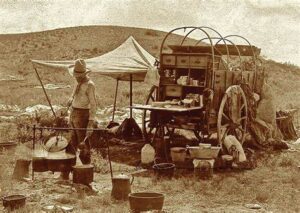 After watching numerous old western shows about cattle drives, most of us would automatically assume that a chuckwagon is a staple on any cattle drive. That is not the case, however. In the early years of cattle drives, the cowboys were supposed to supply their own food, and had to survive on what they could forage and carry. With that in mind, hiring cowboys for the drive was tough. Cowboys were usually paid about $25 to $40 a month, so to have to buy food out of that too, doesn’t make cattle driving a “get rich quick” kind of job. Basically, cattle ranchers ended up with people who couldn’t get a job anywhere else, and they usually weren’t loyal or very good at their job. They might even walk off the job before the drive was over.
After watching numerous old western shows about cattle drives, most of us would automatically assume that a chuckwagon is a staple on any cattle drive. That is not the case, however. In the early years of cattle drives, the cowboys were supposed to supply their own food, and had to survive on what they could forage and carry. With that in mind, hiring cowboys for the drive was tough. Cowboys were usually paid about $25 to $40 a month, so to have to buy food out of that too, doesn’t make cattle driving a “get rich quick” kind of job. Basically, cattle ranchers ended up with people who couldn’t get a job anywhere else, and they usually weren’t loyal or very good at their job. They might even walk off the job before the drive was over.
It was a big problem for ranchers, who needed to have reliable, as well as capable cowboys to work the drives. Finally, one rancher, a man named Charles Goodnight, while pondering the problem he had in getting good working cowboys for his cattle drive. Then, he hit upon an idea. Goodnight created a type of field kitchen covered wagon. It is unknown if the name comes from the fact that the inventor is Charles (Chuck) or if it referenced chuck as a slang term for food. “Goodnight modified a Studebaker-manufactured covered wagon, a d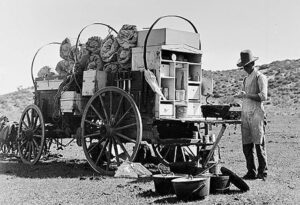 urable Civil War army-surplus wagon, to suit the needs of cowboys driving cattle from Texas to sell in New Mexico. He added a ‘chuck box’ to the back of the wagon, with drawers and shelves for storage space and a hinged lid to provide a flat working surface. A water barrel was also attached to the wagon and canvas was hung underneath to carry firewood. A wagon box was used to store cooking supplies and cowboys’ personal items.” It is said that Goodnight’s main motivation for the chuckwagon, was to be able to hire a better class of cowboy and keep them throughout the cattle drive.
urable Civil War army-surplus wagon, to suit the needs of cowboys driving cattle from Texas to sell in New Mexico. He added a ‘chuck box’ to the back of the wagon, with drawers and shelves for storage space and a hinged lid to provide a flat working surface. A water barrel was also attached to the wagon and canvas was hung underneath to carry firewood. A wagon box was used to store cooking supplies and cowboys’ personal items.” It is said that Goodnight’s main motivation for the chuckwagon, was to be able to hire a better class of cowboy and keep them throughout the cattle drive.
“Chuckwagon food typically included easy-to-preserve items such as baked beans, salted meats, coffee, and sourdough biscuits. Food would also be gathered en route. There was no fresh fruit, vegetables, or eggs available, and meat was not fresh unless an animal was injured during the run and therefore had to be killed. The meat they ate was greasy cloth-wrapped bacon, salt pork, and beef, usually dried, salted or smoked. On cattle drives, it was common for the “cookie” who ran the wagon to be second in authority only to the “trailboss.” The cookie would often act as cook, barber, dentist, and banker.” A typical trail boss made $100 to $125 a month, and the cook usually made about $60. 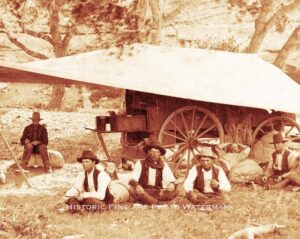 The cook was vital to the cattle drive and was not to be crossed. The men were to keep their distance from the chuckwagon, because dust would get in the food. The horses left camp downwind of the chuckwagon for the same reason. No one dared take the last serving of food until they were sure that everyone had been served. To leave food on their plates was an insult to the cook. The cooks had long days…up before dawn to prepare food. After the men left for work, they cleaned up camp and washed dishes, then went to the next camp site to begin dinner for the men’s arrival. After dinner they cleaned up and went to bed. The next day would soon arrive. They more than earned their wage and the special wagon they got to use.
The cook was vital to the cattle drive and was not to be crossed. The men were to keep their distance from the chuckwagon, because dust would get in the food. The horses left camp downwind of the chuckwagon for the same reason. No one dared take the last serving of food until they were sure that everyone had been served. To leave food on their plates was an insult to the cook. The cooks had long days…up before dawn to prepare food. After the men left for work, they cleaned up camp and washed dishes, then went to the next camp site to begin dinner for the men’s arrival. After dinner they cleaned up and went to bed. The next day would soon arrive. They more than earned their wage and the special wagon they got to use.
 Vnukovo Airport was experiencing heavy fog on November 5, 1946. Due to the resulting low visibility conditions and a high number of aircraft bound for Moscow, including an Aeroflot LI-2 (registration CCCP-L4181) that was being ferried from Voronezh to Moscow. The LI-2, along with a number of other planes, were put in a holding pattern for 75 minutes. These things are a common practice, but maybe not for so long.
Vnukovo Airport was experiencing heavy fog on November 5, 1946. Due to the resulting low visibility conditions and a high number of aircraft bound for Moscow, including an Aeroflot LI-2 (registration CCCP-L4181) that was being ferried from Voronezh to Moscow. The LI-2, along with a number of other planes, were put in a holding pattern for 75 minutes. These things are a common practice, but maybe not for so long.
Finally, at 5:45pm, local time, the crew of the LI-2 was cleared to land and began their approach, still in a thick fog. It was a difficult approach, and the crew decided to go around. In all, five ADF approaches under radar guidance were attempted. Unfortunately, during the fifth approach the plane suffered fuel exhaustion. Immediately, the plane lost altitude and struck light poles and crashed. Fog creates very unique problems, and to complicate matters, that night three Aeroflot aircraft also crashed near Vnukovo Airport, killing a total of 19 occupants.
The first one, Aeroflot LI-2 (registration CCCP-L4181) crashed near Yamshchina, Moskovskaya, Russia. The determined cause was fuel exhaustion after being in a holding pattern for two hours, killing all five crew on board. Then, an Aeroflot C-47 (registration CCCP-L946) crashed in fog at Vnukovo Airport while attempting a go-around after being in a holding pattern for two hours, killing 13 of the 26 on board. Finally, an Aeroflot LI-2 (registration CCCP-L4207) crashed at Vnukovo Airport after repeated landing attempts due to fuel exhaustion after being in a holding pattern for 75 minutes, killing one of 26 on board.
The Vnukovo Airport is Moscow’s oldest operating airport. Originally opened for military operations during the Second World War, it became a civilian facility after the war. The Soviet government approved its construction in  1937, because the older Khodynka Aerodrome, which was located much closer to the city center, was becoming overloaded. That airport closed by the 1980s. Vnukovo was built by several thousand inmates of Likovlag, which was a Gulag concentration camp created specifically for this purpose. Vnukovo opened on July 1, 1941. While the airport was old, it was not the cause of the November 5, 1946 crashes. More likely the pilots and flight controllers, who were preoccupied with the fog, simply forgot to monitor the fuel levels, and missed the fact that they were dangerously low. It is odd, however, that three were missed at the same time, and very sad that 19 people lost their lives because of it.
1937, because the older Khodynka Aerodrome, which was located much closer to the city center, was becoming overloaded. That airport closed by the 1980s. Vnukovo was built by several thousand inmates of Likovlag, which was a Gulag concentration camp created specifically for this purpose. Vnukovo opened on July 1, 1941. While the airport was old, it was not the cause of the November 5, 1946 crashes. More likely the pilots and flight controllers, who were preoccupied with the fog, simply forgot to monitor the fuel levels, and missed the fact that they were dangerously low. It is odd, however, that three were missed at the same time, and very sad that 19 people lost their lives because of it.
 The Cold War, and the Soviet Union’s sudden announcement on August 30, 1961, to end a three-year moratorium on nuclear testing, brought about a shift in US policy, and a number of to nuclear test operations. One, known as Operation Fishbowl was a series of high-altitude nuclear tests in 1962 that were carried out by the United States as a part of the larger Operation Dominic nuclear test program. Flight-test vehicles were designed and manufactured by Avco Corporation. The test planned for the first half of 1962, called Bluegill, Starfish and Urraca were originally planned for the first half of 1962, but the first test attempt was delayed until June. Planning was complex, but necessary.
The Cold War, and the Soviet Union’s sudden announcement on August 30, 1961, to end a three-year moratorium on nuclear testing, brought about a shift in US policy, and a number of to nuclear test operations. One, known as Operation Fishbowl was a series of high-altitude nuclear tests in 1962 that were carried out by the United States as a part of the larger Operation Dominic nuclear test program. Flight-test vehicles were designed and manufactured by Avco Corporation. The test planned for the first half of 1962, called Bluegill, Starfish and Urraca were originally planned for the first half of 1962, but the first test attempt was delayed until June. Planning was complex, but necessary.
The launch sites were planned from Johnston Island in the Pacific Ocean north of the equator. The island was the chosen launch site, rather than the other locations in the Pacific Proving Grounds. However, the testing was not without push back. Even as early as 1958, Lewis Strauss, t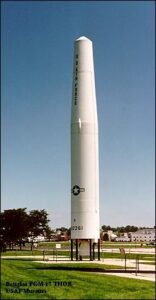 hen chairman of the United States Atomic Energy Commission, opposed doing any high-altitude tests at locations that had been used for earlier Pacific nuclear tests. The motivation for concern was the fear of the flash from the nighttime high-altitude detonations might blind civilians who were living on nearby islands. Still, Johnston Island was a remote location. It was more distant from populated areas than the other potential test locations. Nevertheless, in order to protect residents of the Hawaiian Islands from flash blindness or permanent retinal injury from the bright nuclear flash, the nuclear missiles of Operation Fishbowl were launched toward the southwest of Johnston Island. The detonation part of the test would be farther from Hawaii.
hen chairman of the United States Atomic Energy Commission, opposed doing any high-altitude tests at locations that had been used for earlier Pacific nuclear tests. The motivation for concern was the fear of the flash from the nighttime high-altitude detonations might blind civilians who were living on nearby islands. Still, Johnston Island was a remote location. It was more distant from populated areas than the other potential test locations. Nevertheless, in order to protect residents of the Hawaiian Islands from flash blindness or permanent retinal injury from the bright nuclear flash, the nuclear missiles of Operation Fishbowl were launched toward the southwest of Johnston Island. The detonation part of the test would be farther from Hawaii.
The Urraca test involved about a 1 megaton yield at very high altitude of just over 621 miles. With the damage caused to satellites by the Starfish Prime detonation, the proposed Urraca test was always controversial. Because they couldn’t put the fears to rest, the Urraca test was finally canceled, and an extensive re-evaluation of the Operation Fishbowl plan as a whole was made during the 82-day operations pause after the Bluegill Prime disaster of July 25, 1962. When prime was added to a test, it indicated that the main test had failed, so when Bluegill Prime failed, it was the second test fail for that test series, which in this case (Bluegill Double Prime), ended in disaster when the Thor suffered a stuck valve preventing the flow of LOX to the combustion chamber. The engine lost thrust and unburned RP-1 spilled down into the hot thrust chamber, igniting and starting a fire around the base of the missile. Bluegill would go on to have two more tests, before they finally achieved success.

A test named Kingfish was added during the early stages of Operation Fishbowl planning. Two low-yield tests, Checkmate and Tightrope, were also added during the project, so the final number of tests in Operation Fishbowl was five. Tightrope was the last atmospheric nuclear test conducted by the United States, as the Limited Test Ban Treaty came into effect shortly thereafter. A total of Seven rockets carrying scientific instrumentation were launched from Johnston Island in support of the Tightrope test, which was the final atmospheric test conducted by the United States. I suppose testing is necessary, and I don’t know where else or how else it could be done, but the whole thing seems crazy to me. I do think that in light of this and other nuclear test disasters, care should be taken to better protect human life.

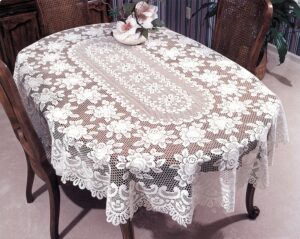 Tablecloths…usually used to dress up a table, often for a holiday dinner these days, were not always used for that purpose. Children wiping their mouths on tablecloths isn’t generally acceptable at the dinner table these days, but that was their original use! It was like a community napkin. Guests were meant to wipe off their hands and face on a tablecloth after a messy feast, and not do this would be considered bad table manners! These days it’s pretty much the opposite. The idea is to try not to “spill” or otherwise mess up the tablecloth.
Tablecloths…usually used to dress up a table, often for a holiday dinner these days, were not always used for that purpose. Children wiping their mouths on tablecloths isn’t generally acceptable at the dinner table these days, but that was their original use! It was like a community napkin. Guests were meant to wipe off their hands and face on a tablecloth after a messy feast, and not do this would be considered bad table manners! These days it’s pretty much the opposite. The idea is to try not to “spill” or otherwise mess up the tablecloth.
While original tablecloths were usually white…another odd idea, considering the practice of wiping one’s mouth and hands with the cloth, today’s version is often colorful, and decorative to match the holiday currently being celebrated. The most common shapes for tablecloths are round, square, oval, and oblong, or rectangular, corresponding to the most common table shapes. Tablecloths usually have an overhang, referred to as the “drop” of about 6 to 15 inches on each side of the table. The shorter drop is usually for casual dining and a longer drop for more formal occasions. Sometimes a floor-length cloth is used. Custom-made tablecloths are also available, and some people choose to make their own.
Some tablecloths are just decorative, and often used on a wooden table to help protect the table from scratches and stains. Others are designed to be spread on a dining table before laying out tableware and food. In formal settings, tablecloths are designed as part of an overall table setting, with coordinating napkins, placemats, or other decorative pieces, and in very formal settings the might also be “runners” overhanging the table at two ends only and “table protectors” which provide a padded layer under a normal tablecloth.
Today’s more casual, and less expensive tablecloths are typically made of cotton, and some have a poly-cotton blend, or a PVC-coated material that can be wiped clean. Of course, any material works, and some people use delicate fabrics like embroidered silk. Today, the biggest consideration, at least in casual settings, is ease of cleanup, so the material might be chosen for its ability to fight stains.
Of course, one more use for a tablecloth, was in shows, where the tablecloth is quickly pulled from under a set table full of food. The idea is to pull it quickly enough to leave the table’s contents in place while pulling the cloth from under them. This trick relies on inertia. It is known as a tablecloth pull or a tablecloth yank. Unless 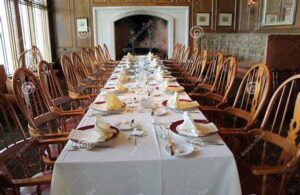
 you are prepared for the cleanup following such a trick, I wouldn’t exactly recommend trying that one. I think most of us knew most of these uses, but maybe not the original use. Nevertheless, now you know. I would be careful using the tablecloth in that way at your next family dinner, however. It might not be appreciated.
you are prepared for the cleanup following such a trick, I wouldn’t exactly recommend trying that one. I think most of us knew most of these uses, but maybe not the original use. Nevertheless, now you know. I would be careful using the tablecloth in that way at your next family dinner, however. It might not be appreciated.
 Cheerleaders are a staple of the sporting scene. Often seen at football games, they are also at other sporting event. Still, football is the main one, but how did cheerleading get started. It wasn’t some sort of organized decision by coaches or schools, but rather it was a spontaneous action that turned into something we all know about and enjoy watching, and something that many girls (and guys too) dream about becoming.
Cheerleaders are a staple of the sporting scene. Often seen at football games, they are also at other sporting event. Still, football is the main one, but how did cheerleading get started. It wasn’t some sort of organized decision by coaches or schools, but rather it was a spontaneous action that turned into something we all know about and enjoy watching, and something that many girls (and guys too) dream about becoming.
November 2, 1898, is officially recognized as the “birth of cheerleading.” It all started at the University of Minnesota, when student Johnny Campbell directed fans in cheering on the Golden Gophers football team, cheering “Rah, Rah, Rah! Ski-u-mah, Hoo-Rah! Hoo-Rah! Varsity! Varsity! Varsity, Minn-e-So-Tah!” That made Campbell the very first cheerleader. The whole thing was so well received, that soon after that, the University of Minnesota organized a “yell leader” squad of six male students, who still use Campbell’s original cheer today. Good thing the name “yell squad” didn’t take!! Prior to Campbell’s date with history, cheering existed, of course, just not in this new form. Prior to November 2, 1898, the fans 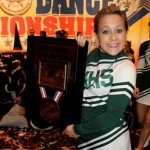 cheered at the game…meaning they yelled, screamed, and jumped up and down. Fans that would start cheers in the stands were called “cheerleaders,” on an unofficial basis, but they really weren’t officially leaders, just initiators. That day however, Campbell made history when he jumped down in front of the fans to lead an organized cheer.
cheered at the game…meaning they yelled, screamed, and jumped up and down. Fans that would start cheers in the stands were called “cheerleaders,” on an unofficial basis, but they really weren’t officially leaders, just initiators. That day however, Campbell made history when he jumped down in front of the fans to lead an organized cheer.
I don’t think everyone realizes just how important the cheerleaders are. Sometimes, when the game seems lost, the cheerleaders are solely responsible for lifting the spirits of fans and players alike. Sometimes, it encourages the players to press on, and other times it just tells them, “We love you anyway.” Today, most high school, college, and  professional sports teams have cheerleaders, with a few notable exceptions. The Cleveland Browns famously or infamously do not and never have had cheerleaders, and for this year neither do the Bills, Bears, Chargers, Giants, Packers, or Steelers. The Dallas Cowboy cheerleaders are probably one of the most famous of cheerleading organizations and for them it is a seriously big production. Tryouts are rigorous and highly competitive. The cheerleading squads these days are bigger than they used to be too. There are also competitions that are held each year too. It is now considered a sport in most schools. In fact, in the colleges, the cheerleaders have to sign a contract to be there and plan to stay with it for the entire season. Usually, there are scholarships attached to cheerleading, and the practice session and games are mandatory, with strict rules on allowed absences. Cheerleaders are an important aspect of college sports, and the squads must be dedicated. Cheerleading has come a long way since 1898, and I think most people would agree, that it’s been a good thing.
professional sports teams have cheerleaders, with a few notable exceptions. The Cleveland Browns famously or infamously do not and never have had cheerleaders, and for this year neither do the Bills, Bears, Chargers, Giants, Packers, or Steelers. The Dallas Cowboy cheerleaders are probably one of the most famous of cheerleading organizations and for them it is a seriously big production. Tryouts are rigorous and highly competitive. The cheerleading squads these days are bigger than they used to be too. There are also competitions that are held each year too. It is now considered a sport in most schools. In fact, in the colleges, the cheerleaders have to sign a contract to be there and plan to stay with it for the entire season. Usually, there are scholarships attached to cheerleading, and the practice session and games are mandatory, with strict rules on allowed absences. Cheerleaders are an important aspect of college sports, and the squads must be dedicated. Cheerleading has come a long way since 1898, and I think most people would agree, that it’s been a good thing.

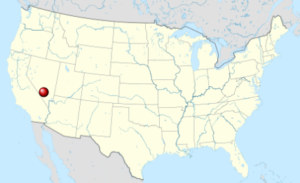 Our government has been known, in its history, to do some things that really were underhanded, and in some cases horrific. The “need” for nuclear bombs naturally facilitated the need for nuclear testing. I think everyone knows that would had to have happened, but on November 1, 1951, the US Army conducted nuclear tests in the Nevada desert that included a “diabolical exercise in which 6500 US Army troops were exposed to the effects of a nearby nuclear detonation and its associated radiation.” When I read that, I was furious. They knew what they were doing, and they did it as an experiment…just to see what would happen to those poor men.
Our government has been known, in its history, to do some things that really were underhanded, and in some cases horrific. The “need” for nuclear bombs naturally facilitated the need for nuclear testing. I think everyone knows that would had to have happened, but on November 1, 1951, the US Army conducted nuclear tests in the Nevada desert that included a “diabolical exercise in which 6500 US Army troops were exposed to the effects of a nearby nuclear detonation and its associated radiation.” When I read that, I was furious. They knew what they were doing, and they did it as an experiment…just to see what would happen to those poor men.
It was called Operation Buster–Jangle. The US Army conducted a series of 7 nuclear tests, that included the November 1st test. In that involuntary one test, the 6500 troops, were dug in foxholes and trenches only 6 miles from an air burst nuclear bomb of 21 kilotons yield. That is about the size of the Nagasaki bomb!! After the soldiers felt the hot nuclear wind blast over them, the wind deposited desert dust in choking clouds upon the men. Then, the soldiers were ordered to get up and march across the blast site to within 900 meters (a little over ½ a mile) of the nuclear “ground zero.” That is incredibly close, and those men were exposed.
The damage done to those men was not well documented, but the US Government later passed the 1990 Radiation Exposure Compensation Act (RECA) to compensate the military veterans exposed to nuclear testing in the 1950’s. The passing of that act is implied acknowledgment of the responsibility of the US government in long term health problems experienced by those troops…without actually placing the blame, and therefore opening the government up to future lawsuits. Basically, the men, were they still alive, or their families, if not, 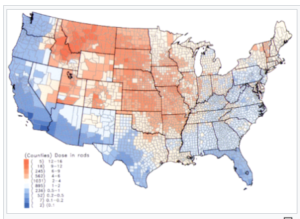
 could theoretically be compensated for their losses. Of course, as many of us have seen with these kinds of cases, the process is very slow, the burden of proof for the men trying to receive compensation is heavy, and the final payout is usually quite low. RECA has awarded over $2.4 billion in benefits to more than 37,000 claimants since its inception in 1990. Still, that’s a small price to pay for the destruction of so many lives.
could theoretically be compensated for their losses. Of course, as many of us have seen with these kinds of cases, the process is very slow, the burden of proof for the men trying to receive compensation is heavy, and the final payout is usually quite low. RECA has awarded over $2.4 billion in benefits to more than 37,000 claimants since its inception in 1990. Still, that’s a small price to pay for the destruction of so many lives.
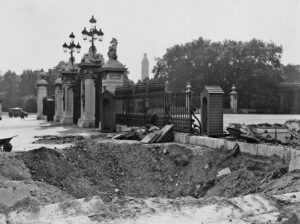 During World War II, the Third Reich run by Adolf Hitler was at war with the world, but at that point, mostly with the British, and especially the British Royal Family. There were a number of bombing campaigns that devastated London, but it was the attack of September 13, 1940, that managed to hit the mark that Hitler would consider, the jackpot. That bombing managed to hit Buckingham Palace. upon hearing that, I wondered, “Where was the family?” Many people tried to leave London, if they had the means. Many of the children were hidden on the country. The rest of the people hid wherever they could…in places like subway tunnels and such. Pretty much everyone had their windows blacked out at night, so that unless there was a moon, homes were well hidden. That summer the German army ramped up their attacks on Britain. London was the prime target of the pounding by the Luftwaffe. Called “The Blitz” attacks, the bombings were very damaging…destroying much of London’s infrastructure.
During World War II, the Third Reich run by Adolf Hitler was at war with the world, but at that point, mostly with the British, and especially the British Royal Family. There were a number of bombing campaigns that devastated London, but it was the attack of September 13, 1940, that managed to hit the mark that Hitler would consider, the jackpot. That bombing managed to hit Buckingham Palace. upon hearing that, I wondered, “Where was the family?” Many people tried to leave London, if they had the means. Many of the children were hidden on the country. The rest of the people hid wherever they could…in places like subway tunnels and such. Pretty much everyone had their windows blacked out at night, so that unless there was a moon, homes were well hidden. That summer the German army ramped up their attacks on Britain. London was the prime target of the pounding by the Luftwaffe. Called “The Blitz” attacks, the bombings were very damaging…destroying much of London’s infrastructure.
Well, the Royal Family certainly had the means to get out, so I assumed that they were in Scottland or somewhere when all this took place. As the leaders of the country, it would certainly make sense to get them to  safety. Nevertheless, when Buckingham Palace was bombed on September 13, 1940, Queen Elizabeth and King George VI were there. On that morning they were relaxing with a cup of tea, when they heard the ‘unmistakable whirr-whirr of a German plane’ and the ‘scream of a bomb’ that was followed by a rumble and a crash. A German raider had dropped five high explosive bombs on the Palace. The areas hit were the Royal chapel, inner quadrangle, Palace gates, and the Victoria memorial. Four members of the Palace staff were injured, one of whom died. Thankfully, the King and Queen went unharmed in the incident. Queen Elizabeth said in a poignant statement, ‘I am glad we have been bombed. It makes me feel I can look the East-End in the face.’ I’m sure he was just trying to be brave, because they were obviously quite shaken up. Her stance strengthened the reputation of the Royal Family in the eyes of the British public.
safety. Nevertheless, when Buckingham Palace was bombed on September 13, 1940, Queen Elizabeth and King George VI were there. On that morning they were relaxing with a cup of tea, when they heard the ‘unmistakable whirr-whirr of a German plane’ and the ‘scream of a bomb’ that was followed by a rumble and a crash. A German raider had dropped five high explosive bombs on the Palace. The areas hit were the Royal chapel, inner quadrangle, Palace gates, and the Victoria memorial. Four members of the Palace staff were injured, one of whom died. Thankfully, the King and Queen went unharmed in the incident. Queen Elizabeth said in a poignant statement, ‘I am glad we have been bombed. It makes me feel I can look the East-End in the face.’ I’m sure he was just trying to be brave, because they were obviously quite shaken up. Her stance strengthened the reputation of the Royal Family in the eyes of the British public.
This wasn’t the first attempt to take out the palace. Days earlier, on September 8th, a 50-kilogram bomb fell on the grounds of the Palace. That one malfunctioned, and didn’t explode, so it was later destroyed in a controlled explosion. Of course, the British Foreign Office immediately recommended that the family should leave the country for a time after the second bomb did so much damage, they refused, and it was viewed as a deep 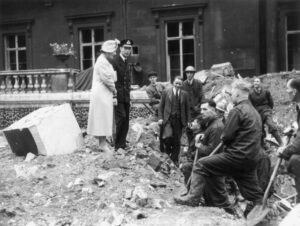 “courage and a commitment to the United Kingdom” that the public appreciated. The Queen went on to say that “The children will not leave unless I do. I shall not leave unless their father does, and the King will not leave the country in any circumstances, whatever. So, it was settled. This act of defiance in the face of the German Blitz gave the country a much-needed boost in their war efforts. The people felt like they were not alone, and they gained a sense of unity throughout the United Kingdom. All of this happened during the Battle of Britain, which began on July 10, 1940. I would say that the efforts were greatly increased, because it ended on October 31, 1940, with a British victory.
“courage and a commitment to the United Kingdom” that the public appreciated. The Queen went on to say that “The children will not leave unless I do. I shall not leave unless their father does, and the King will not leave the country in any circumstances, whatever. So, it was settled. This act of defiance in the face of the German Blitz gave the country a much-needed boost in their war efforts. The people felt like they were not alone, and they gained a sense of unity throughout the United Kingdom. All of this happened during the Battle of Britain, which began on July 10, 1940. I would say that the efforts were greatly increased, because it ended on October 31, 1940, with a British victory.
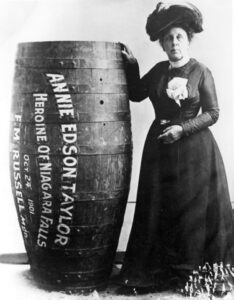
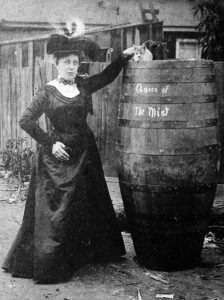 People have always been risk takers…always looking for that next thrill. Many people think that the biggest risk takers are the guys, but that is not always the case. On October 24, 1901, as a birthday gift to herself on her 63rd birthday, Anna “Annie” Edson Taylor, who was an American schoolteacher, became the first person to survive a trip over Niagara Falls in a barrel. Annie wasn’t just out to make a name for herself, but rather her motives were purely financial. Somehow, she thought this “claim to fame” would make her rich, but she never made much money from her adventure.
People have always been risk takers…always looking for that next thrill. Many people think that the biggest risk takers are the guys, but that is not always the case. On October 24, 1901, as a birthday gift to herself on her 63rd birthday, Anna “Annie” Edson Taylor, who was an American schoolteacher, became the first person to survive a trip over Niagara Falls in a barrel. Annie wasn’t just out to make a name for herself, but rather her motives were purely financial. Somehow, she thought this “claim to fame” would make her rich, but she never made much money from her adventure.
Annie was born on October 24, 1838, in Auburn, New York. She was one of eight children born to Merrick Edson and Lucretia Waring. Her father owned a flour mill and died when she was 12 years old, leaving enough money to provide a comfortable living for the family. Annie took a four-year training course, graduating with honors, and became a schoolteacher. While at college, she met David Taylor. They were married and had a son who died in infancy. Sadly, her husband died soon after. During her working years, the widowed Taylor, was often between jobs and locales.
Eventually, she moved to Bay City, Michigan, planning to become a dance instructor, except that there were no dance schools in Bay City at that time. No problem…Taylor opened her own. She moved to Sault Saint Marie in 1900 to teach music. From there, she traveled to San Antonio, Texas. Then she and a friend went to Mexico City to find work, but that venture completely failed, so she returned to Bay City. All of her moving and a number of other bad choices caused Taylor to find herself in hard times, Then, her house burned down, as well as a poor investment with a clergyman left her pretty broke. She claimed to be only 42 years old at the time and said that she could make money more easily if she were younger. Because she had always associated money and class with success, Taylor believed that she needed money to hold her place in the world. So, in the 1900 Federal Census, she declared her year of birth as 1860. She thought that if she was thought to be younger, she could make money easier.
Then, in what was most likely her craziest scheme ever, and hoping to secure her later years financially, Taylor decided she would be the first person to ride over Niagara Falls in a barrel. It seems that her money-making schemes were in endless supply. Taylor used a custom-made barrel constructed of oak and iron and padded with a mattress to make for her crazy trip. The barrel launch was delayed several times, mainly because no one wanted to be part of potential suicide. Finally, she decided she would have to do this on her own. First, two days before her own attempt, Taylor sent a domestic cat over the Horseshoe Falls in her barrel to test its strength to see if the barrel would break or not. Contrary to rumors at the time, the cat survived the plunge and seventeen minutes later, after she was found with a bleeding head, posed with Taylor in photographs. Then, on her 63rd birthday, the barrel was put over the side of a rowboat, and Taylor climbed in, carrying with her, her lucky heart-shaped pillow. The lid was screwed down, and friends used a bicycle tire pump to compress the air in the barrel. They plugged the hole used for the air with a cork, and Taylor was set adrift near the American shore, south of Goat Island.
The barrel was carried by river currents over the Canadian Horseshoe Falls, which has since been the site for all successful daredevil stunting at Niagara Falls. Shortly after her plunge, rescuers reached her barrel. Taylor was discovered to be alive and relatively uninjured, having received just a small gash on her head. The daring trip took less than twenty minutes, but it was some time before the barrel was actually opened. Taylor was helped out of the barrel by Carlisle Graham, her friend and the first man to run the rapids on a raft. After the journey, Taylor told the press, “If it was with my dying breath, I would caution anyone against attempting the feat … I would sooner walk up to the mouth of a cannon, knowing it was going to blow me to pieces than make another trip over the Fall.” Finally, she spoke some sense!! 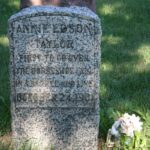
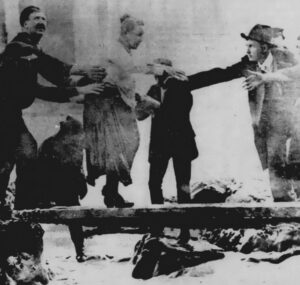
On February 23, 1921, Taylor was taken to the Niagara County Infirmary in Lockport, New York. Still lying about her age, she claimed to be 57. She died on April 29, 1921, aged 82 and was interred next to her friend and fellow daredevil Carlisle Graham, in the “Stunter’s Rest” section of Oakwood Cemetery in Niagara Falls, New York. Since she died penniless, public donations were collected to pay the costs of her funeral, which was held on May 5, 1921. She blamed her bad health and near blindness to her trip over the falls, twenty years earlier.

